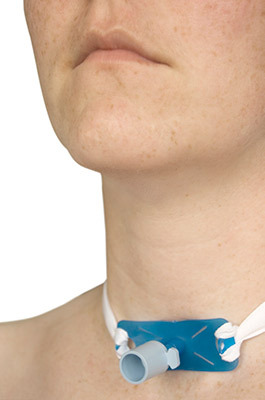What is an endotracheal tube?

An endotracheal (en-doh-TRAY-key-ull) tube is a breathing tube. The tube is placed in the trachea (“windpipe” that goes from the mouth to the lungs) and lets air pass to and from the lungs from the ventilator (“breathing machine”) that is used during surgery.
The endotracheal tube is taken out when the patient is fully awake and can breathe on his/her own. This usually happens in the intensive care unit (ICU). While the tube is in place, the patient cannot talk, eat or drink.
What is a tracheostomy?
Sometimes, a ventilator is needed longer than expected to help the patient breathe. The patient may also need extra help to remove secretions (mucus and other substances) from the lungs. A build-up of lung secretions can lead to infection and pneumonia. In these cases, the doctor may suggest removing the endotracheal tube and replacing it with a tracheostomy, which makes it easier and safer to deliver oxygen to the lungs and clear secretions. A tracheostomy can also help the patient come off the ventilator more quickly.
A small incision (opening) is made in the throat. A tube (“trach” tube) is placed in the opening, and the patient uses this opening to breathe. It is more comfortable to have a trach tube than an endotracheal tube. The tracheostomy procedure can be done in the operating room or in the ICU. The majority of tracheostomies done by Cleveland Clinic Thoracic Surgeons are done using less invasive, percutaneous techniques. This reduces the risk of bleeding. The patient may also have less discomfort and pain. Pain medication and other pain management techniques will be used to help the patient stay comfortable while recovering from the procedure.
What happens after the tracheostomy is done?
The nurse and respiratory therapist will suction secretions from the trach tube. This keeps the breathing area clear. The secretions may be bloody for the first few days after the procedure. This is normal. The patient’s healthcare team will keep a close eye on the tracheostomy area and check for signs of infection.
Does the tracheostomy keep the patient from communicating and eating?
It is sometimes possible for a patient with a tracheostomy to verbally communicate. But, you can expect that the patient will not be able to talk. The nurses will help you find the best ways to communicate (writing, shaking/nodding, etc.) with the patient. The patient will likely be fed through a small tube that goes directly to the stomach.
Is a tracheostomy permanent?
The patient’s healthcare team will work to help the patient recover as quickly as possible and get the patient off of the ventilator. Once the patient can breathe normally, the tube can be removed. The opening usually closes on its own and heals in 10 to 14 days.
Sometimes, the trach tube needs to stay in place for a longer period of time. This depends on the patient’s condition and the reason for the tracheostomy. If this is the case, a special cap or valve is used to help the patient talk. If the trach tube needs to stay in place after the patient leaves the hospital, a nurse will teach the patient and family members how to care for the tube.
What are the risks of a tracheostomy?
All types of surgery involve the risk of complications. The patient’s healthcare team will make every effort to reduce these risks. Complications due to a tracheostomy are rare but can include bleeding, damage to the larynx ("voice box") or airway that causes permanent changes to the voice, the need for another surgery, infection, scarring of the airway or neck and trouble swallowing. If the need for a tracheostomy is not an emergency, the doctor will talk to the patient and family members before the procedure to explain the risks and benefits of the procedure.